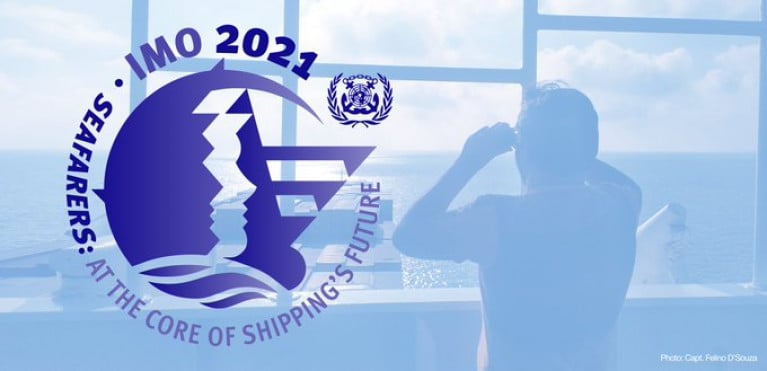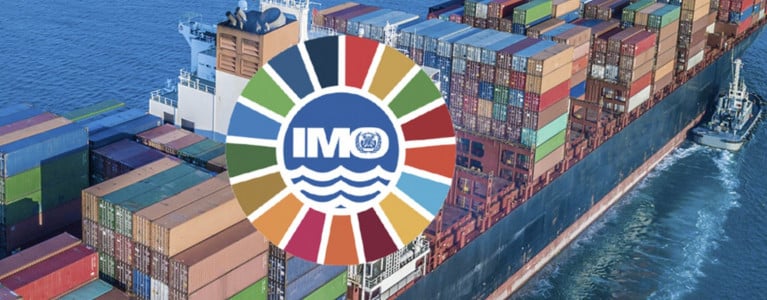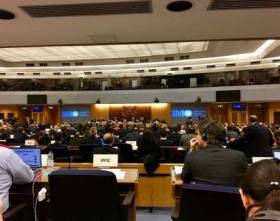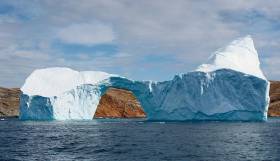Displaying items by tag: IMO
International Maritime Organization (IMO)’s Commitment to Preservation of Marine Environment on World Maritime Day 2023
This year sees the 50th anniversary of the adoption of the International Convention for the Prevention of Pollution from Ships (MARPOL), the primary global treaty for the prevention of pollution of the marine environment by ships from intentional, operational or accidental causes.
To mark the International Maritime Organization (IMO)'s dedication to the objectives of this landmark treaty, the theme of World Maritime Day 2023 is "MARPOL at 50 – Our commitment goes on". IMO is calling on Member States and all in the maritime industry to celebrate the day and be inspired to build upon the positive impacts MARPOL has brought. IMO's work towards a sustainable future with enhanced protection of our planet and ocean continues.
IMO-UNEP-Norway Innovation Forum
On World Maritime Day, the IMO-UNEP-Norway Innovation Forum 2023 (takes place today, 28 September at IMO Headquarters, London, and online). The Forum promotes innovation to accelerate the transition of the marine sector towards a zero- and low-emission future. Topics addressed through high-level panel discussions include: environmental performance; reducing plastic litter from ships; supporting innovation in marine fuel production; decarbonizing the maritime sector; unlocking green finance; and partnerships and collaboration.
Embracing the future by building on the past
In his message on the World Maritime Theme for 2023, the IMO Secretary-General, Kitack Lim, noted achievements already made in regulating to protect ocean health, but made it clear that significant work still faces the shipping industry:
"Shipping must embrace decarbonization, digitalization and innovative technology, including automation – while ensuring the human element is kept front and centre of the technological and green transition to ensure a sustainable planet for future generations. MARPOL has made a difference to shipping – and to the health of our ocean – and will continue to do so, as we look ahead to the next 50 years," Secretary-General Lim said.
Read the IMO Secretary-General's full message HERE, or watch the VIDEO
On World Maritime Day, the United Nations Secretary-General, António Guterres, called for "all-hands-on-deck" to realize a just and equitable transition to a greener, decarbonized shipping industry. Mr. Guterres said:
"Through the decades, MARPOL has made important contributions to protecting our planet and ocean by making shipping safer and cleaner. Looking ahead, let us build on the legacy of this convention and together steer towards a more sustainable and prosperous future for this critical industry – and a safer future for humanity."
Read the UN Secretary-General's message in full here.
MARPOL makes a difference
The theme, "MARPOL at 50 – Our commitment goes on", throws a spotlight on IMO's important regulatory work over half a century to protect the environment from the impact of shipping, and emphasizes the Organization's ongoing commitment to do more in support of the UN 2030 Agenda for Sustainable Development and the 17 Sustainable Development Goals (SDGs).
The downloadable graphics below detail the six Annexes contained in MARPOL and how they protect the marine environment.
Get involved in World Maritime Day 2023
IMO invites Member States and everyone in the maritime industry to celebrate the day on social media. Please use the hashtag #WorldMaritimeDay and tag @IMOHQ on X (formerly Twitter), Instagram, Facebook and LinkedIn).
After dark on 28 September, IMO's London Headquarters will be bathed in blue light to promote World Maritime Day 2023. IMO invites Member States, intergovernmental organizations in cooperation with IMO, and non-governmental organizations in consultative status with IMO to join them by lighting up their own landmarks.
Please send us pictures of your blue-illuminated local landmarks via our social media channels (see above) or email them to [email protected]. A selection will be included in this photo gallery.. Read more information here.
Transport Minister Eamon Ryan has welcomed the adoption by the International Maritime Organization (IMO) of a revised 2023 strategy on the reduction of greenhouse gas emissions from ships.
Significantly, this includes a provision for an economic element on the basis of a maritime GHG emission pricing mechanism.
The 2023 GHG Strategy was adopted at the 80th session of the Marine Environment Protection Committee in London. Ireland has been supportive of the highest level of ambition throughout the negotiation of this strategy.
The revised strategy sets a goal of net zero GHG emissions from ships by or around 2050. This is a significant increase in ambition compared to the initial 2018 strategy which targeted a 50% reduction compared to 2008 levels.
The strategy has introduced important indicative checkpoints along this 2050 pathway. The 2030 checkpoint is set at reducing GHG emissions from ships by at least 20%, while striving for 30%. For 2040, this stands at 70% while striving for 80%. Both checkpoints are in comparison to 2008 levels.
In an important move, the strategy includes a basket of candidate mid-term GHG reduction measures including an economic element on the basis of a maritime GHG emissions pricing. This is something that Minister Ryan and Ireland have been advocating for a number of years, the Department of Transport says.
Commenting after the IMO’s revised strategy announcement on Friday (7 July), Minister Ryan said: “At last year’s COP27 in Egypt the key issue was climate finance and agreement on a loss and damage fund to help the poorest countries, states and people in the world, who are being disproportionately impacted by the devastation of climate change.
“At COP, global leaders like Mary Robinson were advocating for a pricing mechanism or levy on carbon heavy industries, like the maritime and aviation sectors. It is really encouraging to see that this globally agreed strategy, which will accelerate the sector’s transition away from polluting fossil fuels, now also, significantly and bravely, provides for a pricing mechanism. The key thing now is to go to the next steps, turning this agreed strategy into action.”
The strategy also includes provision for a new target of at least 5%, striving for 10% uptake of zero or near-zero GHG emission technologies, fuels and/or energy sources by 2030.
There was further agreement on the timeline for introducing mid-term measures, which will be crucial for the implementation of this strategy.
Much work remains in the process, with the agreement to initiate a comprehensive impact assessment of the remaining candidate measures. This timeline will see measures adopted by 2025 and enter into force by 2027, while giving appropriate consideration to assess possible impacts on states.
While Ireland and others had called for higher levels of ambition during the negotiation process, the department says it was important to secure widespread support to reach such an agreement that can now be implemented globally.
This resulting 2023 strategy marks an important milestone along the maritime fuel transition, it adds, and it is hoped that it will send a clear signal to the maritime and fuel industries on the commitment to phase out GHG emissions from shipping.
The adoption by unanimous support from member states of the IMO is also important in ensuring a high level of solidarity in delivering on the ambition of net zero by 2050, it says.
International Maritime Organisation (IMO) Chief Bids Farewell to Queen Elizabeth II
The secretary general of the International Maritime Organisation, Kitack Lim joined the chorus of international tributes flowing in for Queen Elizabeth II, who died yesterday (Thursday, 8th September) at 96.
“Her genuine interest in shipping and maritime matters was remarkable,” Lim said in a statement.
Queen Elizabeth II was married for 74 years to Prince Philip, Duke of Edinburgh, who was trained in the Royal Navy and served with distinction in several theatres of World War II.
The UK being the host country of the IMO, Lim said he had “the immense honour and privilege” to meet Elizabeth in person during her long reign.
The IMO held its first meeting in London in 1959 at Church House in central London. In 1983, it was the Queen herself who inaugurated the new IMO headquarters at Albert Embankment on the south bank of the Thames.
Prince Philip had laid the building’s foundation stone four years before.
For more Tradewinds reports on the response of the IMO which is a United Nations specialised agency with responsibility for the safety and security of shipping and the prevention of pollution by ships.
The IMO has 175 Member States in which Afloat adds the UK became a member in 1949 and Ireland joined two years later in 1951.
In addition the organization has three Associate Members.
The International Maritime Organization (IMO)’s World Maritime University (WMU) in Sweden is calling all Seafarers to take part in a survey.
As gCaptain reports, the survey is open to seafarers who are currently working on any commercial ship, or have worked on such ships at any time after 1 February 1997, to participate in a survey on hours of work/rest, workload, and ship manning.
WMU is conducting the survey in collaboration with the International Federation of Shipmasters’ Associations (IFSMA), the Nautical Institute (NI), the Institute of Marine Engineering, Science and Technology (IMarEST), and the International Seafarers’ Welfare and Assistance Network (ISWAN).
The survey is part of research funded by the ITF Seafarers’ Trust. At the conclusion of the survey, WMU will work with the maritime community to consider improvements.
The survey should take no more than 20 minutes to complete and all responses will remain strictly confidential. You are welcome to share the survey link with seafarers in your network. The participation deadline is 31 December 2022.
Follow the link to complete the survey which leads to choice of language before continuing the survey.
World Maritime Day Highlights "Seafarers: At the Core of Shipping’s Future"
Today is World Maritime Day and where the International Maritime Organisation (IMO) and the global maritime community come together to celebrate the annual event with a focus on this year's theme: "Seafarers: At the Core of Shipping's Future".
As part of the celebrations, which are a fixture in the global shipping calendar, four seafarers will join in an interactive webinar to discuss issues of importance to the future of the sector.
(Seafarers today will share their views during a webinar on World Maritime Day at 12:00 BST - join here: bit.ly/3AVorVw)
In addition, the IMO Headquarters in London will be one of several iconic landmarks to be illuminated in blue, kicking off an annual initiative to unite the maritime community and raise awareness of the vital contribution of shipping to the world. It will also draw attention to seafarers and their core role in shipping and its future.
"Shipping drives world trade and that trade simply does not happen without seafarers. While the challenges of automation and digitalization - not to mention decarbonization - will drive change in shipping, we will always need well-trained and motivated seafarers. We must ensure a diverse and expert workforce for the ships of the twenty-first century and beyond," said IMO Secretary-General Kitack Lim.
The 2021 theme was chosen as part of a year of action for seafarers, who play a vital role as key workers for global supply chains but are facing unprecedented hardship due to the COVID-19 pandemic.
During 2021, IMO has interviewed several seafarers about topics of importance to them and the future of the sector. The profiles (on the IMO website and social media channels (Twitter, Facebook, LinkedIn and Instagram) spotlight issues related to the human element of shipping, including the safety and security of life on board ships, seafarers' well-being, and the importance of ensuring an appropriately trained and qualified workforce, ready to meet the challenges and opportunities of digitalization and automation.
Interactive webinar
On World Maritime Day, seafarers Ayse Basak, Yrhen Balins, Marwa Elselehdar and Thomas Madsen will be the seafarer panelists during a webinar which will focus on issues such as crew change, diversity, safety, and the environment.
To join the webinar, please visit the World Maritime Day page.
Illuminating in blue
This year IMO will launch a new annual initiative to unite the maritime community and raise awareness of the vital contribution of shipping to the world by bathing the IMO building in blue light on World Maritime Day. The Memorial to Seafarers, which was inaugurated 20 years ago in 2001, will be lit up at sunset, along with the IMO emblem on the building. A video feed will be shared on social media. This symbolic effort, supported by the International Transport Workers' Federation (ITF), will be echoed around the globe with many maritime stakeholders joining in and sharing their images and videos on social media using the hashtag #WorldMaritimeDay.
Secretary-General Lim has invited IMO Member States, intergovernmental organizations and non-governmental organizations in consultative status to join in this annual initiative by lighting up their most iconic buildings, bridges, maritime ports, ships, monuments, museums and other landmarks on World Maritime Day each year.
Social Media
IMO welcomes participation in World Maritime Day events from stakeholders on social media, especially seafarers. Individuals and organizations are encouraged to share images on social media channels using the hashtag #WorldMaritimeDay. Photographs can also be sent to: [email protected] World maritime theme for 2022
'New technologies for greener shipping' has been chosen as the World Maritime theme for 2022, reflecting the need to support a green transition of the maritime sector into a sustainable future, while leaving no one behind.
Find out more
Click World Maritime Theme 2021 (imo.org) to read more about World Maritime Day 2021 and find the message from the Secretary-General, video and more.
Today is World Maritime Day 2020 – Sustainable Shipping for a Sustainable Planet
Today is World Maritime Day which the International Maritime Organisation (IMO) and the global maritime community have come together to celebrate the annual event. The 2020 theme is "Sustainable Shipping for a Sustainable Planet".
2020 saw everyone across the globe affected by the COVID-19 pandemic. Yet this global crisis has demonstrated the importance of shipping as the most reliable, efficient and cost-effective method of transporting goods internationally. Shipping remains the leading facilitator of the global economy, carrying more than 80% of global trade, said IMO Secretary-General Kitack Lim in his World Maritime Day message.
"Therefore, shipping and maritime will be at the heart of the economic recovery and future sustainable growth far into the future, both at sea and ashore, supporting an inclusive and resilient economy to underpin the achievement of the sustainable development goals. 'Sustainable Shipping for a Sustainable Planet', our theme for 2020 couldn't be more relevant now and for years to come," Secretary-General Lim said.
"In the post-COVID world, much focus will be directed at the 2030 Agenda for Sustainable Development and the 17 Sustainable Development Goals adopted by all UN Member States in 2015. These goals are as relevant as ever, and shipping is essential for sustainable development. The 2030 Agenda will only be realized with a sustainable transport sector supporting world trade and facilitating the global economy," Secretary-General Lim added.
The role of sustainable shipping for a sustainable planet will be highlighted during an IMO-hosted online event on 24 September.
At a separate event held on the margins of the UN General Assembly on World Maritime Day, Mr. Lim will highlight the important role of shipping and put a spotlight on the humanitarian crisis faced by seafarers who are stranded at sea due to travel restrictions imposed by governments to contain the spread of the virus. Mr. Lim will warn that seafarers should not be the collateral victims in this pandemic. He will underline that Governments must act in a coordinated manner to recognize seafarers as key workers, exempting them from travel restrictions, and implement the recommended framework of protocols for safe crew changes"
UN Secretary-General message on World Maritime Day
In a message issued on World Maritime Day, UN Secretary-General António Guterres said that "the theme of this year's World Maritime Day – 'Sustainable Shipping for a Sustainable Planet' – has gained extraordinary resonance as shipping has continued to transport more than 80 per cent of world trade, including vital medical supplies, food and other basic goods that are critical for the COVID-19 response and recovery."
Mr. Guterres reiterates his concern for seafarers stranded at sea and renews his appeal to Governments "to address their plight by formally designating seafarers and other marine personnel as "key workers", ensuring safe crew changes and implementing the protocols developed by UN agencies, as well as the International Chamber of Shipping and the International Transport Workers' Federation, allowing stranded seafarers to be repatriated and others to join ships."
A World Maritime Day IMO online event was hosted by IMO this morning which involved a high-level panel of speakers to debate "Sustainable Shipping for a Sustainable Planet". In additon a message by Kitack Lim, Secretary-General, IMO is available through this video link here.
According to a new report, sharing the cost of the International Maritime Organization’s new sulphur rules (see: Irish Sea ferry operator) across the containerised supply chain could mark a new era of greener shipping transportation.
As LloydsLoadingList writes the report by Boston Consulting Group highlighted that compliance requirement from January 2020 is forecast to cost carriers between $25bn and $30bn in additional fuel costs to 2023.
“By selling environmentally friendly services effectively, lines can share these costs with customers as well as promote the ultimate objective of greener supply chains,” Boston Consulting Group said. “The entire ecosystem of value chain participants — including freight forwarders, cargo owners, and consumers — should be willing to bear their fair share of the costs.”
Lines will feel the heaviest impact from higher costs in the first year of IMO 2020 implementation, when it is expected to reach between $10bn and $12bn. Subsequent years would see smaller annual increases due to the shrinking price differential between high- and low-sulphur fuels.
But compliance costs would not be uniform across trade routes and carriers, according to Boston Consulting Group.
For more on this story click here.
#ports&shipping - The International Maritime Organization (IMO) Marine Environment Protection Committee (MEPC 74) is to commence this week in London, a discussion on an EU proposal on exhaust gas cleaning systems (scrubbers).
The proposal, which has been submitted by the EU 28 Member States and the European Commission, aims to start the discussion at international level on the discharges from scrubbers into the water, especially in sensitive areas such as ports.
To protect the water quality and to respect the EU standards imposed by the Water Framework Directive, some EU Member States have taken initiatives to limit liquid discharges from scrubbers in port areas.
“Water quality is a great priority for European ports being continuously in the annual Top 10 of European ports’ environmental priorities. The scrubber discharges into the water is currently triggering different approaches and measures in the EU Member States. It is important to start the discussion at international level on the possible impact of these discharges as soon as possible in an open and transparent way, using the evidence available. This must lead to a more coordinated global approach to the issue, if possible. With the upcoming IMO 2020 sulphur cap, the issue is becoming a priority,” says European Sea Ports Organisation Secretary General, Isabelle Ryckbost.
Ireland Supports Heavy Fuel Oil Ban From Arctic Shipping
#Shipping - Ireland supports a move toward banning the use of heavy fuel oil from Arctic shipping, following a meeting of the International Maritime Organization (IMO) in London earlier this month.
Plans to develop a ban on heavy fuel oil (HFO) from Arctic shipping, along with an assessment of the impact of such a ban, were agreed upon during the IMO’s Marine Environment Protection Committee, which closed on Friday 13 April.
The move was welcomed by the Clean Arctic Alliance campaign, which called on IMO member states to “make every effort” to adopt and implement a ban on “the world’s dirtiest fuel” by 2021.
“Thanks to inspired and motivated action taken by a number of IMO member states to move towards a ban on heavy fuel oil, Arctic communities and ecosystems will be protected from the threat of oil spills, and the impact of black carbon emissions”, said Dr Sian Prior, lead advisor to the coalition of 18 NGOs working to end HFO use as marine fuel in Arctic waters.
“A ban is the simplest and most effective way to mitigate the risks of HFO – and now we’re calling on the IMO to ensure that this ban will be in place by 2021. Any impact assessment must inform, but not delay progression towards an Arctic HFO ban, and member states must ensure that Arctic communities are not burdened with any costs associated with such a ban.”
The proposal to ban HFO as shipping fuel from Arctic waters was co-sponsored by Finland, Germany, Iceland, Netherlands, New Zealand, Norway, Sweden and the United States.
The proposal for a ban, along with a proposal to assess the impact of such a ban on Arctic communities from Canada, was supported by Australia, Belgium, Czech Republic, Denmark, Estonia, France, Ireland, Japan, the League of Arab States, Poland, Portugal, Spain, Switzerland, and the UK.
Support from Denmark is particularly notable as it is the sixth Arctic nation to support the ban, according to the Clean Arctic Alliance.
“With Denmark the sixth Arctic nation to back a ban on HFO from Arctic shipping, the green alliance of Arctic nations have sent a clear message to the IMO,” said Kåre Press-Kristensen, senior advisor in the Danish Ecological Council.
“With both the Danish government and the Danish shipping industry united to ban HFO, we hope to gain further international support for the ban from more nations and progressive parts of the shipping industry. Next step will be to engage Greenland further in planning and preparing for the ban.”
Alaskan native Verner Wilson, senior oceans campaigner for Friends of the Earth US and a member of Curyung Tribal Council, with Yupik family roots in the Bering Strait region between Russia and the US, said: “I am grateful that IMO has advanced a ban on HFO to help protect Arctic communities and our traditional way of life.
“For thousands of years we have relied on our pristine waters and wildlife – and now the IMO has taken this important step to help protect our people and environment.”
The Clean Arctic Alliance says there “widespread support from within the industry” for a HFO ban, citing the Association of Arctic Expedition Cruise Operators, the Norwegian Shipowners Association and icebreaker company Arctia as among those who have expressed support.
#SeafarersMatter - Today 25 June is the Day of the Seafarer (DotS) an annual event which celebrates and recognises the role that people have on our oceans.
The theme of this year's Dots event run by the International Maritime Organisation (IMO) is that 'Seafarers Matter'
DotS was established in a resolution adopted by the 2010 Diplomatic Conference in Manila to adopt the revised STCW Convention. Its stated purpose is to recognize the unique contribution made by seafarers from all over the world to international seaborne trade, the world economy and civil society as a whole.
The resolution "encourages Governments, shipping organizations, companies, shipowners and all other parties concerned to duly and appropriately promote the Day of the Seafarer and take action to celebrate it meaningfully".
On this Day of the Seafarer, the organiers wanted particularly for ports to engage and by having seafarer centres demonstrate how much seafarers matter to them. The idea is for ports and seafarer centres to share and showcase best practices in seafarer support and welfare.
During today special activities for seafarers will be held, for example the following events:
Social events organised in port to celebrate seafarers
Public open day at seafarer centres
Free wi-fi in port for a day
































































